Range Rover Evoque: Automatic Transmission/Transaxle External Controls - Vehicles With: AWF21 6-Speed Automatic Transmission
General Specification

Torque Specifications

External Controls - Component Location
COMPONENT LOCATION
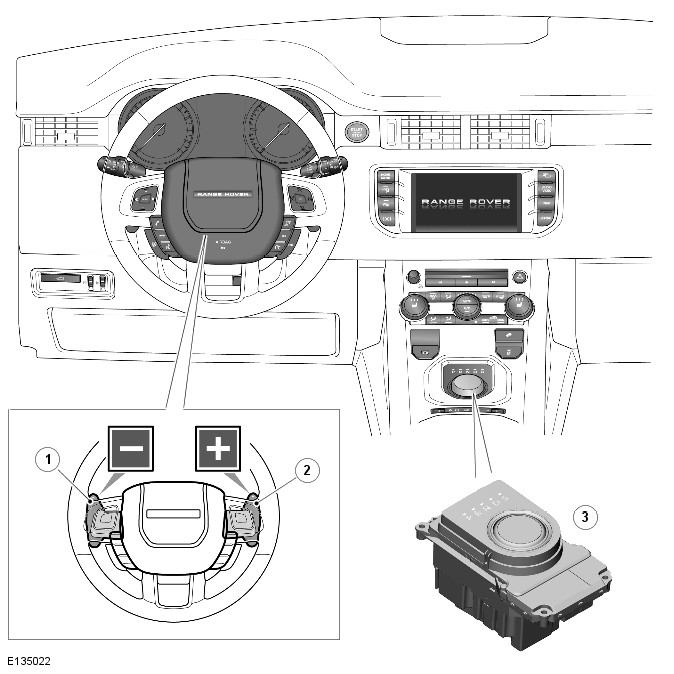
- Downshift paddle switch
- Upshift paddle switch
- Transmission Control Switch (TCS)
External Controls - Overview
OVERVIEW
The external controls comprise a rotary TCS (transmission control switch) and two steering wheel mounted paddle switches.
The TCS transmits driver transmission selections to the Gear Shift Module (GSM) and the TCM (transmission control module) for transmission mode selections. The paddle switches allow the driver to initiate gear shifts in all transmission modes; 'D' drive, 'S' manual CommandShift.
External Controls - System Operation and Component Description
System Operation
OPERATION
NOTE: Refer to Automatic Transmission section 307-01 for electrical Control Diagram
Transmission Control Switch (TCS)
Rotation of the TCS (transmission control switch) to any of the five positions is sensed by the TCM (transmission control module) and the Gear Shift Module (GSM) via the high speed CAN (controller area network). The TCM and the GSM react according to the selected position if all parameters for that selection are met.
The TCS has a magnetic system using Hall effect sensors to determine the position of the switch. The 'S' (Sport) position selection allows the TCM to operate the transmission as a semi-automatic 'CommandShift' system. Gear selections are sensed by the TCM when the driver operates the steering wheel paddle switches. Once the TCS position is confirmed, the GSM to rotates the transmission selector shaft (if required) and outputs applicable information on the high speed CAN which is received by the TCM to activate the correct gear and to instrument cluster to display the selected mode or gear in the instrument cluster message center.
The paddle switches can be used on a temporary basis when the TCS is in the 'D' position to override the automatic gear selection if required.
Paddle Switches
The paddle switches are hardwired to the speed control switch on the steering wheel. Operation of a paddle switch completes a ground path to the speed control switch. The speed control switch converts the completed ground signal into a LIN (local interconnect network) signal which is passed via the clockspring and the steering wheel module to the CJB (central junction box). The CJB converts the signal into a high speed CAN signal to the TCM.
Pulling the LH (left-hand) downshift (-) paddle switch provides down changes and pulling the RH (right-hand) upshift (+) paddle switch provides up changes. The first operation of either paddle switch, after 'S' sport mode is selected, puts the transmission into permanent manual CommandShift. Rotation of the TCS back to the 'D' position returns the transmission to conventional automatic operation.
Temporary operation of CommandShift mode can also be operated with the TCS in the 'D' position. Operation of either the upshift or downshift paddle switches activates the manual CommandShift mode operation. If the TCS is in 'D', CommandShift will cancel after a time period or can be cancelled by pressing and holding the upshift (+) paddle switch for approximately 2 seconds.
Neutral and Park Shift Lock
The shiftlock strategy is controlled by the GSM. Shiftlock is activated when the TCS is in 'P' or 'N' and the engine is not running.
The shift lock is a requirement for the TCS. The switch is always locked at ignition on when the engine is not running, except after an engine stall when the selector is not in 'P' (Park) or 'N' (Neutral). If, when driving with the TCS in 'S', 'D' or 'R' at a speed of more than 10 km/h (6 mph), the driver selects 'P' or 'N' without the brake pedal depressed, the TCS will be immediately locked once the vehicle speed falls to below 10 km/h (6 mph).
With the brake pedal pressed, the TCS will remain unlocked for as long as the brake pedal remains pressed, regardless of vehicle speed. The transmission will only engage the Park once the vehicle speed is less than 10 km/h (6 mph). If the driver selects 'N' and releases the brake pedal with a vehicle speed of less than 10 km/h (6 mph), the TCS will be locked 2 seconds after 'N' is selected. The TCS will remain locked until the driver presses the brake pedal again.
Component Description
DESCRIPTION
Transmission Control Switch (TCS)
The TCS is a rotary switch installed in the floor console and controls the driver transmission selections.
The TCM and the GSM allow the transmission to be operated as a conventional automatic unit by selecting P R N D on the TCS. Rotation of the TCS allows the selection of P R N D S. Depressing and rotating the TCS clockwise from the D position, S mode can be selected. The TCS is a fully electronic rotary transmission switch with no mechanical connection to the transmission. Mechanical operation of the transmission corresponding to selections made on the TCS is performed by a Gear Shift Module (GSM), located above the TCM on the transmission casing.
Refer to: Transmission Description (307-01 Automatic Transmission/Transaxle - Vehicles With: AWF21 6-Speed Automatic Transmission, Description and Operation).
The TCS rises from its console once the engine is running. When the engine is stopped with the TCS in any position other than N, it retracts into the console again. If the TCS is in position N when the engine is stopped, it remains in the raised position for up to 10 minutes, for use in a drive-through car wash for example. After 10 minutes the TCS automatically retracts. The TCS also retracts if P is selected within the 10 minute period. If the TCS does not rise from the console when the engine is started, but electrical power is supplied to the TCS, the retracted TCS can still be rotated to make selections.
If electrical power to the TCS is lost, the TCS will not rise from the console when the engine is started and the retracted TCS cannot be rotated. The TCS contains an internal interlock solenoid to prevent the switch from being rotated when the engine is not running.
The engine can be stopped with the TCS in any position. Once the engine is stopped the switch will automatically reset to the P position and the transmission Park lock will be engaged, except if the TCS is in the N position when the engine is stopped.
LED (light emitting diode)'s on the TCS illuminate to display the selected position. If the brake pedal is not depressed when a selection is made, the selected position LED flashes and the mode selection is not performed.
Paddle Switches
Two gear change paddle switches are fitted at the rear of the steering wheel and allow the driver to operate the transmission as a semi-automatic manual transmission using the CommandShift feature. Each paddle switch has three connections; ground, illumination PWM (pulse width modulation) supply and ground switch signal.
The LH paddle switch (-) controls the downshifts and the RH paddles switch (+) controls the upshifts.
Emergency Park Release
The 'shift by wire' system has no mechanical provision to remove the vehicle from Park in the event of a system fault. A service mode is available which allows the TCS to rise without the engine running to allow selection of Neutral when a fault condition exists.
The following procedure will initiate the service mode:
- Put the ignition on (power mode 6).
- Hold one of the paddle switches and depress the brake pedal continually for 10 seconds. Service mode is now active and the TCS will rise from the console.
- Service mode will remain active until the ignition is off or the engine is started.
If there is a system power failure and the service mode cannot be activated, the GSM must be removed and the transmission selector shaft manually rotated to the Neutral 'N' position. Refer to the relevant service repair procedure for access details.
External Controls
Principles of Operation
For a detailed description of the automatic transmission/transaxle external controls system and operation, refer to the relevant Description and Operation section of the workshop manual.
REFER to: External Controls (307-05 Automatic Transmission/Transaxle External Controls - Vehicles With: AWF21 6-Speed Automatic Transmission, Description and Operation) / External Controls (307-05 Automatic Transmission/Transaxle External Controls - Vehicles With: AWF21 6-Speed Automatic Transmission, Description and Operation) / External Controls (307-05 Automatic Transmission/Transaxle External Controls - Vehicles With: AWF21 6-Speed Automatic Transmission, Description and Operation).
Inspection and Verification
CAUTION: Diagnosis by substitution from a donor vehicle is NOT acceptable. Substitution of control modules does not guarantee confirmation of a fault, and may also cause additional faults in the vehicle being tested and/or the donor vehicle.
NOTE: Check and rectify basic faults before beginning diagnostic routines involving pinpoint tests.
1. Verify the customer concern.
2. Visually inspect for obvious signs of mechanical or electrical damage.
Visual Inspection

3. If an obvious cause for an observed or reported concern is found, correct the cause (if possible) before proceeding to the next step.
4. If the cause is not visually evident, check for Diagnostic Trouble Codes (DTCs) and refer to the DTC Index.
DTC Index
For a list of Diagnostic Trouble Codes (DTCs) that could be logged on this vehicle.
Gear Shift Module
Removal
NOTE: Removal steps in this procedure may contain installation details.
1. Disconnect the battery ground cable.
Refer to: Specifications (414-01 Battery, Mounting and Cables, Specifications).
2. Refer to: Air Cleaner (303-12, Removal and Installation).
Refer to: Air Cleaner (303-12A Intake Air Distribution and Filtering - TD4 2.2L Diesel, Removal and Installation).
3. Torque: 10 Nm
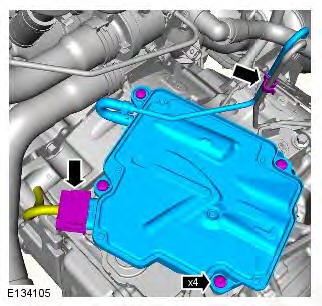
Installation
1. To install, reverse the removal procedure.
2. Using the diagnostic tool, calibrate the gear shift module (GSM).
Transmission Control Switch (TCS)
Removal
NOTE: Removal steps in this procedure may contain installation details.
1. Refer to: Floor Console Upper Section (501-12 Instrument Panel and Console, Removal and Installation).
2. Torque:
- M5 bolt 1.5 Nm
- Screw 1.1 Nm
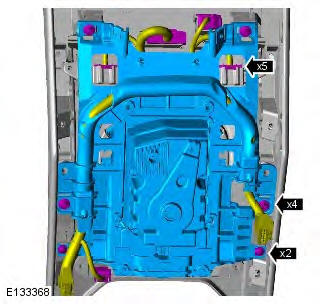
3. Torque: 1.5 Nm
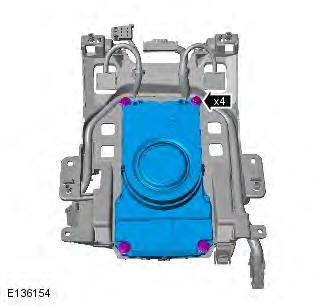
Installation
1. To install, reverse the removal procedure.
Transmission Control Switch (TCS) Knob
Removal
NOTE: Removal steps in this procedure may contain installation details.
1. CAUTIONS: Do not start the engine.
Care must be taken to avoid damaging the surrounding components.
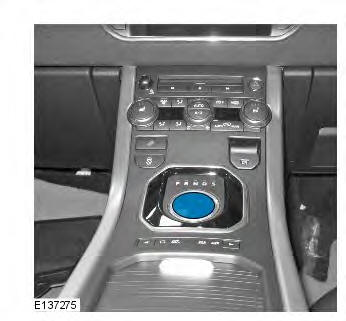
2.
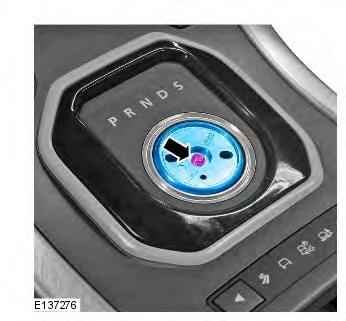
Installation
1. CAUTION: Make sure that a new component is installed.
NOTE: Make sure to install the TCS plastic carrier to the TCS knob.
To install, reverse the removal procedure.
Emergency Park Position Release Lever
Removal
WARNING: Chock the wheels and make sure that all personnel are clear of the vehicle before carrying out the following procedure.
NOTES: To be carried out when the vehicle has no electrical power.
Removal steps in this procedure may contain installation details.
1. Disconnect the battery ground cable.
Refer to: Specifications (414-01 Battery, Mounting and Cables, Specifications).
2. Refer to: Air Cleaner (303-12, Removal and Installation).
Refer to: Air Cleaner (303-12A Intake Air Distribution and Filtering - TD4 2.2L Diesel, Removal and Installation).
3. Torque: 10 Nm
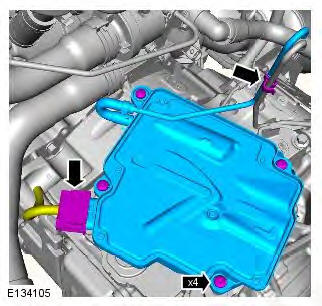
4. NOTE: Make sure that the second position anti-clockwise is selected.
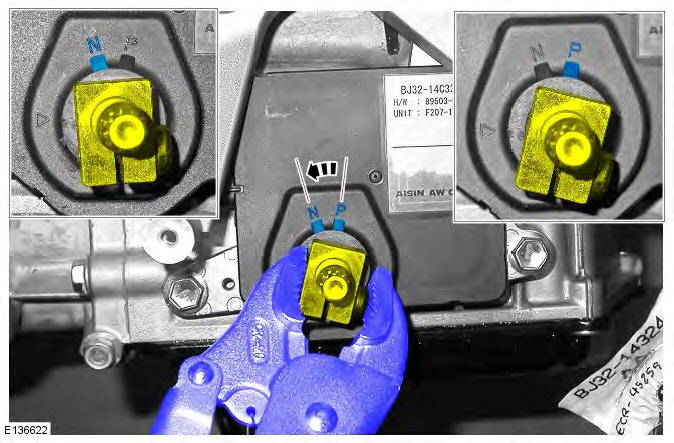
Installation
1. CAUTION: Make sure that the transmission is returned to the park position.
To install, reverse the removal procedure.
2. Using the diagnostic tool, re-calibrate the gear shift module (GSM).

